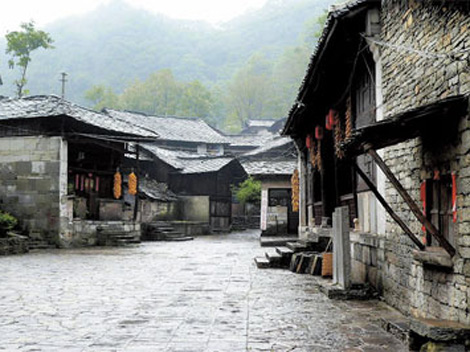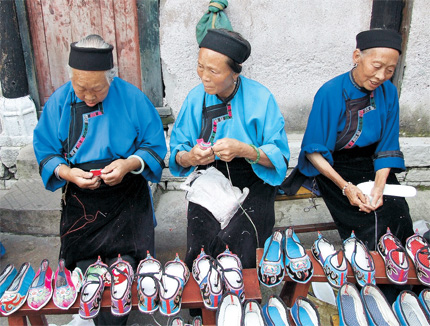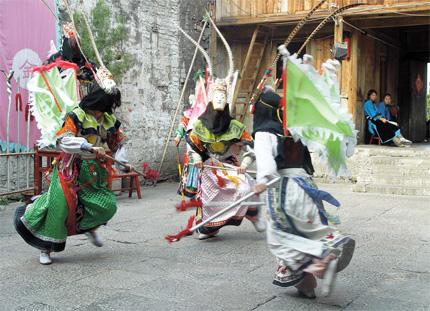
For 600 years, Tunpu people have been living in fortress-like stone houses and keeping the old Han culture.

Local Tunpu women in Ming Dynasty clothing make traditional cloth shoes for sale in Guizhou Province.

Wearing nuo masks, artists perform the traditional dixi in Tianlong Tunpu Village in Guizhou Province.
GUIZHOU is home to 34 ethnic groups of China's total 56. A clan of Han Chinese, an overall majority in China but known as Tunpu people here, has strived very hard to maintain their traditions of old Han culture.
Although more than 600 years have passed, Tunpu people are still living in fortress-like stone houses and wearing Ming Dynasty (1368-1644) clothing. They also still observe the traditional Chinese calendar and perform military rituals for entertainment.
Historically, Tunpu people preferred stone houses with small holes as windows for defensive purposes. When attacked, they would stay inside the house and shoot the invaders from the window.
History has it that in 1381, Ming Emperor Zhu Yuanzhang sent 300,000 soldiers southwest (today's Guizhou and Yunnan provinces) to repress the Yuan (1271-1368) rebels still lingering in the area.
After the pacification, the soldiers stayed behind, lived in the garrison (tunpu in pinyin) and became farmers. Later their families joined them, and also some landless poor and minor criminals from the inland. It was the first large-scale Han migration recorded to southwestern China.
Living in a complicated web of different cultural backgrounds and traditions, these "outsiders" learned to keep to themselves so that they could better defend and protect their families and properties when there were conflicts.
Today the small and peaceful village of Tianlong Tunpu in Guizhou's Anshun City is regarded as a "living fossil" of old Han culture.
In the village, one family's yard is connected to another with winding, narrow lanes between houses. It is said the village layout resembles a chart of bagua (Eight Trigrams), a maze of pathways that let you in but don't let you out.
An open-air teahouse is located at the entrance of the village, which offered us free tea before we entered the village.
A middle-aged waitress wearing a light-blue outfit with broad sleeves prepared out tea.
According to the guide, she is dressed in the Fengyang style, named after Emperor Zhu's hometown, Fengyang in Anhui Province. Women get their fringe shaved the night before they get married and a white band is used to make a tight bun with the rest of their hair.
"Does it have something to do with the mourning ritual when many Tunpu women lost their husband or sons in wars?" someone asked.
"You mean the white band?" the guide said. "It shows a women's status in a family. A senior woman may wear a black band, which means she is the eldest, and thus the most revered in the family."
The guide added that married women wear white to wish for a long marriage.
Entering the lanes of the village, there were some older women wearing less elaborate Fengyang clothes. They were sitting against the walls and making embroidered shoes. Men were working in shops that sell wood carvings and silver jewelry.
A group of kids were back from school, satchels on their backs. None wore any traditional clothing. They played along the road, chatting happily. One of the villagers threw them a branch of cherries, which he had just cut from one of his cherry trees as they passed by his courtyard.
Passing the school, we were taken to an open-air theater. A show was being staged by a group of masked actors in warrior costumes. An LCD screen on the backdrop showed it was an excerpt from the "Romance of the Three Kingdoms."
This local singing and dancing is called dixi, or "ground play," originating from jun nuo, or "military opera," a drama performed as a ritual to raise the spirits of the soldiers before a fight.
As descendants of soldiers, Tunpu people have retained this military opera and several shows are staged each year during the Spring Festival to drive away bad spirits and bring good luck to the village.
Opera masks are hand-carved and made of wood. Each has a different name due to its role in the play. Before they are used by the performers, a rooster will be slaughtered to splash blood over the masks while the mask carver chants blessings.
The leader of the theater said: "Only a blessed mask has a life, and thus carries the spirits of a character."
Other places worth a visit in Guizhou
Huangguoshu Waterfall
Guizhou boasts the biggest waterfall in Asia. Huangguoshu (Yellow Fruit Tree) Waterfall is 78 meters high and 101 meters wide. It is on the Baishui River in Anshun, 95 kilometers from Guiyang, the capital city.
You can hear its roaring sound about 200 meters away. The closer you approach, the louder the sound becomes.
A lane of narrow steps lead to a cave behind the waterfall and this is the closest you can get to touching the water.
Hongfeng Lake
Known as a place with very little flat land, Guizhou has a vast set of plains, mountains and plateaus. Karst areas make up more than 60 percent of Guizhou's topography. Among the karst parks is Hongfeng (Red Maple) Lake in Qingzhen County, 33 kilometers from Guiyang.
Billed as "the pearl of Guizhou Plateau," the lake is divided into four parts by a cluster of more than 1,000 karst hills: the north, the south, the middle and the rear lakes.
Covering an area of 57 square kilometers and holding 600 million cubic meters of water, it is the largest artificial lake in Guizhou, 10 times the size of West Lake in Hangzhou. The lakes are blue, the rocks red and the maple trees a blend of green and orange.
A lone Drum Tower etches against the clouded sky on top a nearby hill, speaking of a rare architectural construction of the Dong minority.





